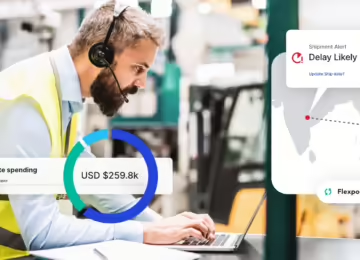When we surveyed businesses across the apparel, retail, ecommerce, food & beverage, and manufacturing industries this year, we found that 73% are planning to scale into a new channel.
Their expansion is unsurprising given the opportunity to reach wider audiences over multiple touchpoints and enhance the quality of the customer experience across more channels.
But scaling to omnichannel also adds complexity to operations, particularly your supply chain. Specifically, you must account for:
- How to manage your growing purchase order (PO) process
- What to do to optimize supplier relationships
- Simplifying how you track shipments and manage new supplier locations
In this blog, we’ll dive into these three complexities of scaling to an omnichannel strategy, and provide tips for managing and automating your supply chain strategy, from PO issuance to delivery to your warehouse. Let’s get started.
1. Managing a growing purchase order process
When you scale to an omnichannel model, the number of purchase orders your team needs to place, track, and manage increases exponentially. This is because as you manage multiple sales channels and an expanded customer base, you’re required to source products from a larger network of suppliers to meet the diverse demands of customers. This leads to an increase in the frequency and volume of POs that need to be processed and impacts the complexity of your PO process.
For example:
- Each of your sales channels may have its own inventory requirements and ordering patterns, which means you may need to place separate orders with different suppliers.
- The dynamic nature of omnichannel retailing means you need to adapt quickly to changes in demand, promotions, or seasonal fluctuations. This results in even more POs to manage.
Tracking and managing this increase in POs becomes a challenging task. It necessitates more intricate collaboration, coordination, and synchronization between you and your suppliers so you can avoid stockouts or even excess inventory. The latter is already proving to be a real threat to brands, with our research finding a staggering 66% of businesses report being overstocked at present. This represents a significant financial burden for them, tying up capital and potentially leading to losses.
Thankfully, there are tools on the market to help brands overcome these complexities and achieve the level of coordination they need for an efficient PO process. Intelligent PO platforms empower consumer brands to:
- Manage and automate their entire PO process
- Collaborate with suppliers in real-time
- Centralize important information
- Gain deeper insights into their entire purchase order lifecycle
- Anticipate delays and mitigate disruptions
All these capabilities help brands build a more streamlined and predictable purchase order process, which is crucial to maintain seamless operations in a rapidly evolving omnichannel environment. For more information on Anvyl’s intelligent PO management platform, click here.
2. Optimizing supplier relationships
The key to a seamless PO process is having quality relationships with your suppliers. This is especially true as you scale into new channels, and need to collaborate with an extensive network of suppliers to meet increased demand across more touchpoints. When this is the case, managing more supplier relationships becomes essential to ensure a reliable and diversified supply chain.
This is easier said than done, however, and there’s a lot you need to account for, like:
- You must identify and onboard suppliers who can fulfill the specific requirements of each channel, whether it’s supplying products for ecommerce fulfillment centers, stocking inventory for physical stores, or partnering with drop-shipping suppliers.
- Each sales channel may have unique sourcing needs, ranging from fast shipping for online orders to regional availability for in-store purchases.
Brands must establish and maintain relationships with a wider range of suppliers to meet these distinct demands effectively. Here are some tips to help you maximize your supplier relationships:
- Define your roles & responsibilities: This clarity can help to prevent misunderstandings, reduce the likelihood of errors or delays, and ultimately improve the overall effectiveness of your omnichannel supply chain.
- Establish clear expectations: Agree on key performance indicators (KPIs) upfront. This enables both you and your supplier base to measure performance and make adjustments where necessary.
- Streamline open communication: This is where an intelligent PO management platform comes into play. These solutions enable you to say goodbye to outdated and siloed communication methods like email, phone, and spreadsheets, and keep your communications together in one place. This means all your conversations are centralized and traceable, fostering easier collaboration and promoting mutual trust.
Although managing supplier relationships gets more tricky when you scale into new channels, it’s worth it. Managing more supplier relationships allow you to tap into their unique capabilities, such as sourcing high-quality products, providing niche or exclusive items, or offering competitive pricing. This allows you to curate a differentiated product portfolio and deliver enhanced value to customers across different channels.
3. Tracking shipments and managing new supplier locations
As retail brands scale to an omnichannel strategy, the process of tracking shipments becomes more complex – especially when you may be working with new suppliers in new locations. According to our new data, 71% of businesses are looking to add more suppliers in the next 3-6 months. This includes nearly a fifth (18%) who say they are doing so to de-risk a potential impact from geopolitical tensions, suggesting that they are indeed expanding their supplier network to new locations.
This diversification is good for consumer brands looking to overcome challenges threatening their supply chain today. As demand for their products increases from launching into new channels, it makes tracking shipments a more daunting task. Supply chain teams will need to:
- Coordinate the delivery schedules from numerous suppliers
- Ensure that they receive timely updates on order status, shipping notifications, and expected delivery times from each supplier to maintain accurate inventory levels
- Integrate their systems with suppliers to ensure smooth order fulfillment and timely delivery
Consumer brands must leverage technology solutions and establish robust supplier management processes. Implementing a centralized system that allows for real-time tracking of shipments and inventory levels is essential.
Thankfully, this is something intelligent PO management platforms empower brands to do, enabling them to streamline communication, automate order processing, and gain visibility into the movement of goods. Especially critical is a brand’s ability to identify shipment delays before they happen, helping supply chain teams to see around corners for at-risk orders, eliminating the need to scramble, and preventing costly adjustments.
By leveraging the power of a modern PO platform, retail brands can manage the complexities of scaling to an omnichannel strategy. To learn more about how Anvyl can help you gain visibility, collaboration, automation, and intelligence in your growing supply chain, contact us today!



